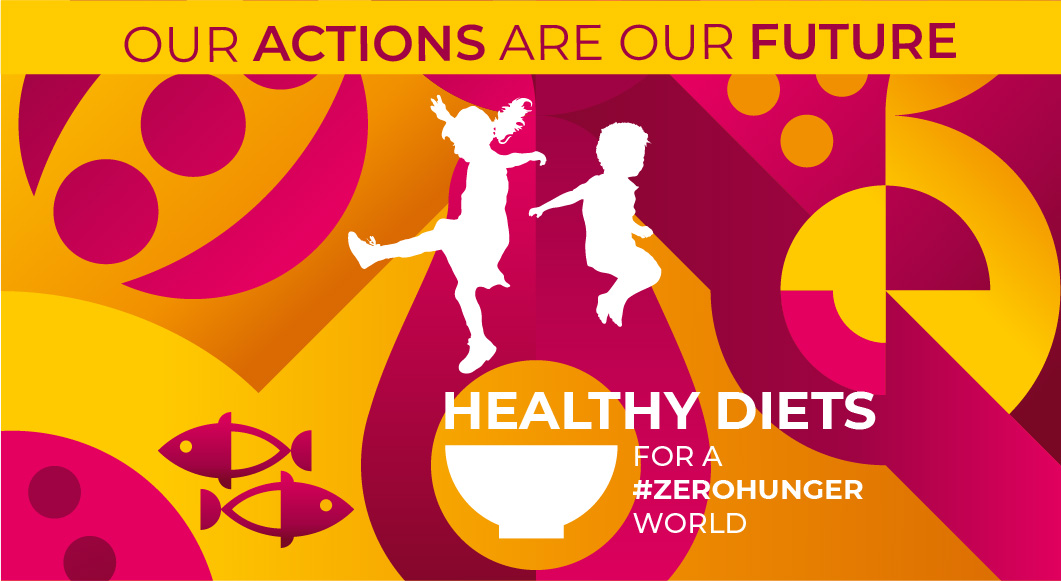World Food Day: promoting food security and healthier diets for #ZeroHunger

Around the world, 736 million people continue to live in extreme poverty and more than 820 million people still suffer from chronic hunger. Meanwhile other forms of malnutrition are also on the rise: overweight and obesity, associated with the development of a significant surge in diet-related non-communicable diseases. Over 670 million adults and 120 million girls and boys (aged 5–19) are obese, and over 40 million children under five are overweight. At the same time, more than two billion people suffer from various micronutrient deficiencies.
Each year, the United Nations Food and Agriculture Organization (FAO) leads the world in observing World Food Day, as an opportunity to highlight the global goals of eradicating poverty through food security, improved food quality, increasing the sustainability and inclusivity of agricultural production, and promotion of healthy nutrition. Achieving Zero Hunger by 2030 is not only about feeding the hungry, but also nourishing people, while nurturing the planet. This year, #WorldFoodDay calls for action across sectors to make healthy and sustainable diets affordable and accessible to everyone.
“ACIAR shares this call to action and is dedicated to increasing food and nutrition security for human health in the Indo-Pacific region,” said ACIAR CEO Prof Andrew Campbell.
“Agricultural research is confronted by new challenges around nutrition insecurity of unprecedented scale and complexity. In the countries where we work it is the ‘triple burden’ of nutrition, where acute hunger and malnutrition coexist with increasing levels of obesity. To meet these complex challenges we must develop new platforms for collaboration, innovation and partnerships across the food system, between the food and health systems, and between the public and private sectors,” Prof Campbell said.
As Australia’s specialist agricultural research-for-development agency, ACIAR is working across the Indo-Pacific region on research projects that are enhancing human nutrition and reducing risks to human health. Some of these projects include:
Developing markets for galip nuts in Papua New Guinea
Nuts have long had huge potential to enhance nutrition of rural communities and in PNG, and through a project co-funded with DFAT and in partnership with the University of the Sunshine Coast, ACIAR has found new marketing opportunities in Port Moresby for Canarium (locally known as ‘galip’) nuts. In a first for PNG, the galip nut is now being sold in commercial markets in East New Britain Province, and demand is strong. The project has found that galip nuts have excellent nutritional value, being richer in iron, magnesium, manganese, phosphorus, zinc and mono-unsaturated fatty acids than peanuts – a popular food source in PNG.
Improving mungbean production in Asia
Mungbean is a highly nutritious and fast-growing crop, and a valued rotation option in rice-based cropping systems of Asia. ACIAR has supported the International Mungbean Improvement Network through several projects with partners in Bangladesh, India, Myanmar and Australia. The network provides access to divers mungbean genetics, so partners can develop varieties that not only yield well, but also are resistant to pests and diseases, and resilient to seasonal variability, especially heat and drought.
Precooked beans for food, nutrition, and income in Kenya and Uganda
Beans are an important food product that contribute to nutritional security, income generation, and employment in Kenya and Uganda. The process of cooking beans can also be a time-consuming one and this can be a deterrent for local women to consider as a staple option for their families. An ACIAR project, in partnership with Canada’s International Development Research Centre (IDRC), is working with farmers in the two countries to boost the production of pre-selected bean varieties, and leverage Public-Private Partnerships in the distribution of pre-cooked bean products through retail outlets, hotels, schools, hospitals and other outlets.



